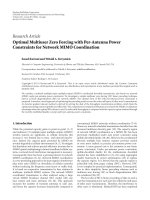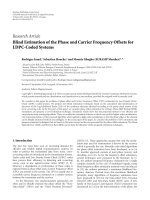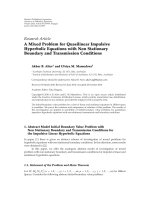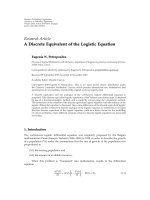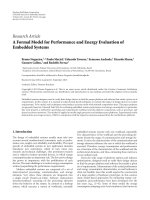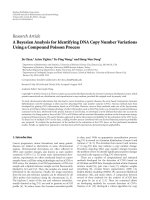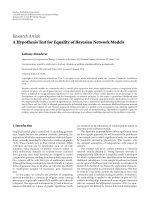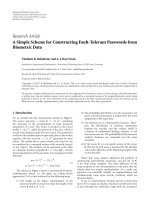Báo cáo hóa học: " Research Article A Novel Face Segmentation Algorithm from a Video Sequence for Real-Time Face Recognition" potx
Bạn đang xem bản rút gọn của tài liệu. Xem và tải ngay bản đầy đủ của tài liệu tại đây (1.98 MB, 6 trang )
Hindawi Publishing Corporation
EURASIP Journal on Advances in Signal Processing
Volume 2007, Article ID 51648, 6 pages
doi:10.1155/2007/51648
Research Article
A Novel Face Segmentation Algorithm from
a Video Sequence for Real-Time Face Recognition
R. Srikantaswamy
1
andR.D.SudhakerSamuel
2
1
Department of Electronics and Communication, Siddaganga Institute of Technology, Tumkur 572103, Karnataka, India
2
Department of Electronics and Communication, Sri Jayachamarajendra College of Engineering, Mysore, India
Received 1 September 2006; Accepted 14 April 2007
Recommended by Ebroul Izquierdo
The first step in an automatic face recognition system is to localize the face region in a cluttered background and carefully seg-
ment the face from each frame of a video sequence. In this paper, we propose a fast and efficient algorithm for segmenting a face
suitable for recognition from a video sequence. The cluttered background is first subtracted from each frame, in the foreground
regions, a coarse face region is found using skin colour. Then using a dynamic template matching approach the face is efficiently
segmented. The proposed algorithm is fast and suitable for real-time video sequence. The algorithm is invariant to large s cale and
pose variation. The segmented face is then handed over to a recognition algorithm based on principal component analysis and
linear discriminant analysis. The online face detection, segmentation, and recognition algorithms take an average of 0.06 second
on a 3.2 GHz P4 machine.
Copyright © 2007 R. Srikantaswamy and R. D. Sudhaker Samuel. This is an open access article distributed under the Creative
Commons Attribution License, which permits unrestricted use, distribution, and reproduction in any medium, provided the
original work is properly cited.
1. INTRODUCTION
In literature, it is found that most of the face recognition
work is carried out on still face images, which are carefully
cropped and captured under well-controlled conditions. The
first step in an automatic face recognition system is to lo-
calize the face region in a cluttered background and care-
fully segment the face from each frame of a video sequence.
Various methods have been proposed in literature for face
detection. Important techniques include template-matching,
neural network based, feature-based, motion-based and face-
space methods [1]. Though most of these techniques are effi-
cient, they are computationally expensive for real time ap-
plications. Skin colour has proved to be a fast and robust
cue for human face detection, localization, and tracking [2].
Skin colour based face detection and localization however
has the following drawbacks: (a) it gives only a coarse face
segmentation, (b) it gives spurious results when the back-
ground is cluttered with skin colour regions. Further, ap-
pearance based holistic approaches based on statistical pat-
tern recognition tools such as principal component analysis
and linear discriminant analysis provides a compact nonlo-
cal representation of face images, based on the appearance
of an image at a specific view. Hence, these algorithms can
be regarded as picture recognition algorithm. Therefore, face
presented for recognition to these approaches should be effi-
ciently segmented, that is, aligned properly to achieve a good
recognition rate. The shape of the face differs from person to
person. Segmenting a face uniformly, invariant to shape and
pose, suitable for recognition, in real-time is therefore very
challenging. Thus, face segmentation “online” in “real-time”
sense from a video sequence still emerges as a challenging
problem in the successful implementation of a face recogni-
tion system. In this work, we have proposed a method which
accommodates these practical situations to segment a face ef-
ficiently from a video sequence. The segmented face is then
handed over to a recognition algorithm based on principal
component analysis and linear discriminant analysis to rec-
ognize the person online.
2. BACKGROUND SCENE MODELING AND
FOREGROUND REGION DETECTION
As the subject enters the scene, the cluttered background is
first subtracted from each frame to identify the foreground
regions. The system captures several frames in the absence
of any foreground objects. Each point on the scene is as-
sociated with a mean and distribution about that mean.
2 EURASIP Journal on Advances in Signal Processing
This distribution is modeled as a Gaussian. This gives the
background probability density function (PDF). A pixel
P(x, y) in the scene is classified as foreground if the Ma-
hanalobis distance of the pixel P(x, y) from the mean μ is
greater than a set threshold. This threshold is found experi-
mentally. Background PDF is updated using a simple adap-
tive filter [3]. The means for the succeeding frame is com-
puted using (1), if the corresponding pixel is classified as a
background pixel,
μ
t+1
= αP
t
+(1− α)μ
t
. (1)
This allows compensating for changes in lighting conditions
over a period of time. Where α is the rate at w hich the model
is compensated for changes in lighting. For an indoor/office
environment it was found that a single Gaussian model [4]of
the background scene works reasonably well. Hence, a single
Gaussian model of the background is used.
3. SKIN COLOUR MODELING
In the foreground regions, skin colour regions are detected.
Segmentation of skin colour region becomes robust only if
the chrominance component used in analysis and research
has shown that skin colour is clustered in a small region of
the chrominance plane [2]. Hence, the C
b
C
r
plane (chromi-
nance plane) of the YC
b
C
r
colour space is used to build the
model where Y corresponds to luminance and C
b
-Cr cor -
responds to the chrominance plane. Skin colour distribution
in the chrominance plane is modeled as a unimodal Gaussian
[2]. A large data base of labelled skin pixels of several people
both male and female has been used to build the Gaussian
model. The mean and the covariance of the database charac-
terize the model. Let c
= [
C
b
C
r
]
T
denote the chrominance
vector of an input pixel. Then the probability that the given
pixel lies in the skin distribution is given by
p(c | skin) =
1
2π
Σ
s
e
−(1/2)(c−μ
s
)
T
Σ
−1
s
(c−μ
s
)
. (2)
Here, c is a color vector, μ
s
and Σ
s
are the mean and covari-
ance, respectively, of the distribution parameters. The model
parameters are estimated from the training data by
μ
s
=
1
n
n
j=1
c
j
,
Σ
s
=
1
n − 1
n
j=1
c
j
− μ
s
c
j
− μ
s
T
,
(3)
where n is the total number of skin colour samples with
colour vector c
j
. The probability p(c | skin) can be used di-
rectly as a measure of how “skin-like” the pixel colour is. Al-
ternately, the Mahalanobis distance λ
s
, computed using (4),
from the colour vector c to mean μ
s
, given the covariance ma-
trix Σ
s
, can be used to classify a pixel as skin pixel [2],
λ
s
(c) =
c − μ
s
T
Σ
−1
s
c − μ
s
. (4)
(a) (b)
(c) (d)
Figure 1: (a) Face segmented using skin colour regions (b) full face
(c) closely cropped face (d) faces of various shapes.
Skin pixel classification may give rise to some false detection
of nonskin tone pixels, which should be eliminated. A, iter-
ation of erosion followed by dilation is applied on the bi-
nary image. Erosion removes small and thin isolated noise
like components that have very low probability of represent-
ing a face. Dilation preserves the size of those components
that were not removed during erosion.
4. DYNAMIC TEMPLATE MATCHING AND
SEGMENTATION OF FACE REGION
SUITABLE FOR RECOGNITION
Segmenting a face, using a rectangular window enclosing the
skin tone cluster will result in segmentation of the face along
with the neck region (see Figure 1(a)). Thus, skin colour
based face segmentation provides only coarse face segmen-
tation, and cannot be used directly for face recognition. The
face presented for recognition can be a full face as shown in
Figure 1(b) or closely cropped face which includes internal
structures such as eye-brows, eyes, nose, lips, and chin region
as shown in Figure 1(c).ItcanbeseenfromFigure 1(d) that
the shape of the face differs from person to person. Here, we
propose a fast and efficient approach for segmenting a face
suitable for recognition.
Segmenting a closely cropped face requires finding a rect-
angle on the face image with the top left corner coordi-
nates (x
1
, y
1
) and bottom right corner coordinates (x
2
, y
2
)
as shown in Figure 2. The face region enclosed within this
rectangle is then segmented.
From a database of about 1000 frontal face images created
in our lab, a study on the relationship between the following
facial features were made. (i) The ratio of distance between
the two eyes W
E
(extreme corner eye points, see Figure 3)to
the width of the face W
F
excluding the ear regions. (ii) The
ratio of the distance between the two eyes W
E
to the height
of the face from the centre of the line joining two eyes to the
chin H
F
. It was found that the ratio W
E
/W
F
vary in the range
0.62–0.72 while the ratio H
F
/W
E
vary in the range 1.1–1.3.
R. Srikantaswamy and R. D. Sudhaker Samuel 3
(x
1
, y
1
)
(x
2
, y
2
)
Figure 2: Rectangular boundary defining the face region.
W
F
W
E
H
F
Figure 3: A sketch of face to define feature ratios.
(a) (b)
Figure 4: Subject with big ears and the corresponding skin cluster.
4.1. Pruning of ears
For some subjects, the ears may be big and extending out-
ward prominently, while for other it may be less prominent.
To obtain uniform face segmentation, the ear regions are first
pruned. An example of the face with ears extending outward
and its corresponding skin tone regions is shown in Figure 4.
The vertical projection of the skin tone regions of
Figure 4(b) is obtained. The plot of this projection is shown
in Figure 5. The columns which have skin pixels less than
20% of the height of the skin cluster are deleted. The result
of this process is shown in Figure 6.
4.2. Rectangular boundary definitions x
1
and x
2
After the ears are pruned, the remaining skin tone regions are
enclosed between two vertical lines as shown in Figure 6.The
projection of left vertical (LV) and right vertical line (RV) on
the x-axis gives x
1
and x
2
, respectively, as shown in Figure 6.
The distance between these two vertical lines gives the width
of the face W
F
.
0
2000
4000
6000
8000
10000
12000
14000
0 10203040 506070 80
Figure 5: Vertical projection of Figure 4(b).
W
F
RV
LV
Figure 6: Skin tone cluster without ears.
4.3. Rectangular boundary definition y
1
and y
2
To fi n d y
1
, the eye brows and eye regions must be localized.
Template matching is used to localize the eyes and eye brow
regions. A good choice of the template containing eyes along
with eyebrows should accommodate (i) variations in facial
expressions, (ii) variations in str u ctural components such as
presence or absence of beard and moustache, and (iii) seg-
mentation of faces under varying pose and scale by using a
pair of eyes as one rigid object instead of individual eyes. Ac-
cordingly, a normalized average template containing eyes in-
cluding eyebrows as shown in Figure 7 has been developed
after considering several face images. The size of the face de-
pends on its distance from the camera, and hence a template
of fixed size cannot be used to localize the eyes. Here, we in-
troduce a concept called dynamic template. After finding the
width of the face W
F
(see Figure 6), the width of the template
containing eyes and eyebrows is resized proportional to the
width of the face W
F
keeping the same aspect ratio. The re-
sized template whose width is proportional to the width of
the face is what we call a dynamic template. As mentioned
earlier, the ratio W
E
/W
F
vary in the range 0.62–0.72. There-
fore, dynamic templates D
k
with widths W
k
are constructed,
where W
k
is given by
W
k
= γ
k
× W
F
k = 1, 2,3, ,6, (5)
4 EURASIP Journal on Advances in Signal Processing
Figure 7: Template.
(x
d
, y
d
)
Figure 8: Four quadrants of skin tone regions.
where γ varies from 0.62 to 0.72 in steps of 0.02 keep-
ing the same aspect ratio. Thus, six dynamic templates
D
1
, D
2
, , D
6
with widths W
1
, W
2
, , W
6
are constructed.
Let (x
d
, y
d
) be the top left corner coordinates of the dy-
namic template on the image as shown in Figure 8.Let
R
k
(x
d
, y
d
) denote the correlation coefficient obtained by
template matching when the top left corner of dynamic tem-
plate D
k
is at the image co-ordinates (x
d
, y
d
). The correlation
coefficient R
k
is computed by
R
k
=
I
T
D
k
−
I
T
D
k
σ
I
T
σ
D
k
,(6)
where I
T
is the patch of the image I whichmustbematched
to D
k
, is the average operator, I
T
D
k
represents the pixel
by pixel product, and σ is the standard deviation over the
area being matched. For real time requirements, (i) tem-
plate matching is performed only within the upper left half
region of the skin cluster (shaded region in Figure 8). (ii)
The mean and the standard deviation of the template D
k
is
computed only once for a given frame. (iii) A lower resolu-
tion image of size 60
× 80 is used. However, segmentation
of the face is made in the original higher resolution image.
Let R
k
max
(x
d
, y
d
) denote the maximum correlation obtained
by template matching with the dynamic template D
k
at the
image coordinates (
x
d
, y
d
). Let R
opt
denote the optimum cor-
relation, that is, maximum of R
k
max
, k = 1, 2, 3, , 6 obtained
with dynamic templates D
k
, k = 1, 2,3, ,6.LetW
∗
k
denote
the width of the dynamic template D
k
which give R
opt
.The
optimal correlation is given by
R
opt
x
∗
, y
∗
= max R
k
max
x
d
, y
d
k = 1, 2, ,6, (7)
where (x
∗
, y
∗
) is the image coordinates which give R
opt
.If
R
opt
is less than a set threshold, the current frame is discarded
and the next frame is processed. Thus, the required point on
the image y
1
is then given by
y
1
= y
∗
. (8)
The distance between the two eyes W
∗
E
is given by the
width of the optimal dynamic template which g ive R
opt
,
therefore W
∗
E
= W
∗
k
.
Figure 9: Average face template.
Figure 10: Some samples of segmented faces with different values.
After finding x
1
, y
1
,andx
2
, we now need to estimate y
2
.
As mentioned earlier, the height of the face varies form per-
son to person and the ratio H
F
/W
E
vary in the range 1.1–1.3.
Several face images, about 450, were manually cropped from
images captured in our lab and an average of all these face
images forms an average face template as shown in Figure 9.
The centre point (x
cen
, y
cen
) between the two eyes is found by
the centre of the optimal dynamic template. From this centre
point, height of the face H
F
k
is computed by
H
F
k
= (1.1+β) × W
∗
E
, k = 1, 2, , 10, (9)
where β is a constant which varies from 0 to 0.2 in steps of
0.02. The face regions enclosed within the boundary of the
rectangle formed using the coordinates x
1
, y
1
, x
2
and the
heights H
F
k
(k = 1, 2, , 10) are segmented and normal-
ized to the size of the average face template. Some of the
faces segmented and normalized by this process are shown
in Figure 10. Correlation coefficient ∂
k
, k = 1, 2, ,10with
these segmented faces and the average face template is given
by (10),
∂
k
=
I
seg
AF
I
seg
A
F
σ
I
seg
σ(AF)
, (10)
where I
seg
is segmented and normalized face images, AF is the
averagefacetemplateasshowninFigure 9,
is the average
operator, I
seg
AF represents the pixel by pixel product, and σ
is the standard deviation over the area being matched. A plot
of correlation coefficient ∂
k
versus H
F
is shown in Figure 11.
For real-time requirement, the mean and the variance of the
average face template are computed ahead of time and used
as constants for the computation of the correlation coeffi-
cient ∂
k
.
The Height (number of pixels) of the face H
F
k
corre-
sponding to the maximum correlation coefficient ∂
max
=
max(∂
k
), k = 1, 2, , 10 is added to the y-coordinates
of the centre point between the two eyes to obtain y
2
.
Finally, the face region enclosed within the boundary of
the rectangle formed using the coordinates (x
1
, y
1
)and
(x
2
, y
2
) is segmented. The results of the proposed face de-
tection and segmentation approach are shown in Figure 12.
R. Srikantaswamy and R. D. Sudhaker Samuel 5
0
0.1
0.2
0.3
0.4
0.5
0.6
0.7
0.8
0.9
Correlation coefficient
88 89 91 93 94 96 97 98 100 102
H
F
Figure 11: Plot of correlation coefficient of H
F
k
normalized to the
same size ∂
k
versus H
F
.
(a) (b)
(c) (d)
(e) (f)
Figure 12: Results of face segmentation using the proposed
method.
The segmented face is displayed at the top right corner win-
dow labeled SEG
FACE of each frame. Observe that the back-
ground is cluttered with a photo of a face in it. The red
rectangle indicates the coarse face localization based on skin
colour. The white rectangle indicates the localization of two
eyes including the eye brows. The green rectangle indicates
the face regions to be segmented using the proposed method.
4.4. Face segmentation with scale and pose variations
The result of the face segmentation with scale variations
is as shown in Figure 13. It can be observed that the pro-
posed face segmentation is invariant to large scale variations.
(a) (b)
Figure 13: Largest and smallest face images segmented by the pro-
posed method.
(a) (b)
(c) (d)
Figure 14: Result of face segmentation with pose variations.
.
The smallest face that can be segmented by the proposed
method is 3.5% of the frame size as shown in Figure 13(b).
However, the largest face that can be segmented depends on
the size of the full face that can be captured when the subject
is very close to the camera. The results of face segmentation
with pose variations are shown in Figure 14.
5. FEATURE EXTRACTION
After the face is segmented, features are extracted. Principal
component analysis (PCA) is a standard technique used to
approximate the original data with lower dimensional fea-
ture vector. The basic approach is to compute the eigenvec-
tors of the covariance matrix and approximate the original
data by a linear combination of the leading eigenvectors [5].
ThefeaturesextractedbyPCAmaynotbenecessarilygood
for discriminating among classes defined by a set of samples.
On the other hand, LDA produces an optimal linear discrim-
inant function which maps the input into the classification
space which is well suitable for classification purpose [6].
6. EXPERIMENTAL RESULTS
A data base of 450 images of 50 individuals consisting of 9
images of each individual with pose, lighting, and expression
6 EURASIP Journal on Advances in Signal Processing
Table 1: Recognition rate of the online face recognition system.
Recognition rate of the online face recognition system
PCA features LDA features
90%
98%
variations captured in our lab was used for training the face
recognition algorithm. The result of the online face recogni-
tion system using the proposed face segmentation algorithm
is shown in Tabl e 1 . The entire algorithm for face detection,
segmentation, and recognition is implemented in C++ on a
3.2 GHz P4 machine which takes an average of 0.06 seconds
per frame to localize, seg ment, and recognize a face. The face
localization and segmentation stage takes an average of 0.04
seconds. The face recognition stage takes 0.02 seconds to rec-
ognize a segmented face. The face segmentation algorithm
is tolerant to pose variations of
± 30 degrees of pan and tilt
on an average. The recognition algorithm is tolerant to pose
variations of
± 20 deg rees of pan and tilt.
7. CONCLUSION
We have been able to de velop an online face recognition sys-
tem which captures image sequence from a camera, detects,
tracks, segments efficiently, and recognizes a face. A method
for efficient face segmentation suitable for real-time applica-
tion, invariant to scale and pose variations is proposed. With
the proposed face segmentation approach followed by lin-
ear discriminant analysis for feature extraction from the seg-
mented face, a recognition rate of 98% was achieved. Further
LDA features provide better recognition accuracy compared
to PCA features.
REFERENCES
[1] M H. Yang, D. J. Kriegman, and N. Ahuja, “Detecting faces
in images: a survey,” IEEE Transactions on Pattern Analysis and
Machine Intelligence, vol. 24, no. 1, pp. 34–58, 2002.
[2] V. Vezhnevets, V. Sazonov, and A. Andreeva, “A survey on
pixel-based skin color detection techniques,” in Proceedings of
the International Conference on Computer Graphics (GRAPH-
ICON ’03), pp. 85–92, Moscow, Russia, September 2003.
[3] C. R. Wren, A. Azarbayejani, T. Darrell, and A. P. Pentland,
“Pfinder: real-time tracking of the human body,” IEEE Transac-
tions on Pattern Analysis and Machine Intelligence, vol. 19, no. 7,
pp. 780–785, 1997.
[4] C. StaufferandW.E.L.Grimson,“Adaptivebackgroundmix-
ture models for real-time tracking,” in Proceedings of the IEEE
Computer Society Conference on Computer Vision and Pattern
Recognition (CVPR ’99), vol. 2, pp. 246–252, Fort Collins, Colo,
USA, June 1999.
[5] M. Turk and A. Pentland, “Eigenfaces for recognition,” Journal
of Cognitive Neuroscience, vol. 3, no. 1, pp. 71–86, 1991.
[6] P. N. Belhumeur, J. P. Hespanha, and D. J. Kriegman, “Eigen-
faces vs. Fisherfaces: recognition using class specific linear
projection,” in Proceedings of the 4th European Conference on
Computer Vision (ECCV ’96), vol. 1, pp. 45–58, Cambridge, UK,
April 1996.
R. Srikantaswamy received his M.Tech de-
gree in indust rial electronics in 1995 and
Ph.D. degree in electronics in 2006 from
University of Mysore, India. He is working
as a Professor in the Department of Elec-
tronics and Communication, Siddaganga
Institute of Technology, Tumkur, India. His
research interests include computer vision
and pattern recognition, neural networks,
and image processing.
R. D. Sudhaker Samuel received his M.Tech
degree in industrial electronics in 1986 from
the University of Mysore, and his Ph.D. de-
gree in computer science and automation
(robotics) in 1995 from Indian Institute
of Science, Bangalore, India. He is work-
ing as a Professor and Head of the Depart-
ment of Electronics and Communication,
Sri Jayachamarajendra College of Engineer-
ing, Mysore, India. His research interests in-
clude industrial automation, VLSI design, robotics, embedded sys-
tems, and biometrics.
